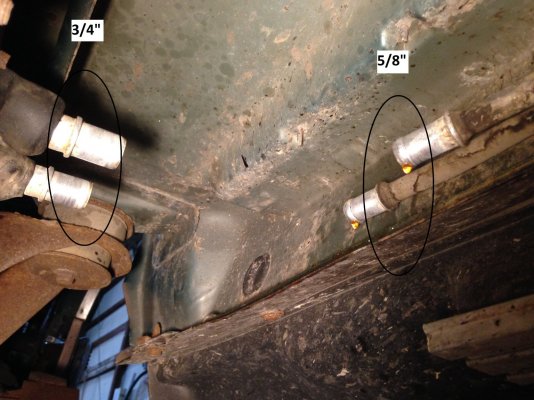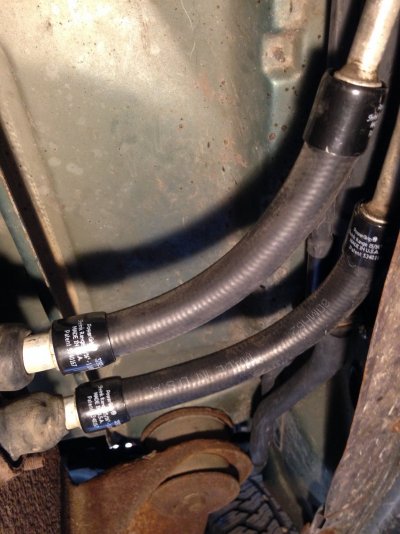I replaced my rear and front heater "hoses" using Gates molded hoses that I fitted together to replace the OEM pieces while retaining the hard lines, e.g., see images attached in this and my other posts in this thread.
This includes the squirrel's nest of hoses in the engine compartment that interconnect the front, rear, and (in some vehicles) coolant shutoff - bypass valve, as well as those to / from the engine and water pump.
I also used bulk hose where appropriate.
Notably, I kept all the OEM coolant hardlines to the rear but removed the deteriorated rubber hose from their ends (i.e., by using a cutter wheel and slicing through the OEM crimp collar - see my later post - and/or removing all quick-connect fittings). This left the bare hard lines from (a) the engine compartment to mid-frame (under the passenger's door), and (b) from mid-frame to the right rear.
I then added rubber hose to (re) join the various hard lines together, as follows. Note that I did not bead / flare the ends of the metal tubes; while I think it's a good idea, I didn't do it. The clamps I used create a tight "hose to pipe" fit that's been working now for four years. Read on...
In the rear, I used off-the-shelf Gates 19129 molded hoses, then cut, trimmed and spliced each with a brass PEX connector to get the proper fitment, and finally "clamped" the two pieces together with Gates PowerFlex (heat shrink) hose clamps. More on this in a later post.
Mid-frame, where the hoses splice the front and rear pipes together, I used Gates 18082 molded hose, 5/8" on one end and 3/4" on the other, to accommodate the different pipe sizes, and simply sized, cut and bent the hose to fit.
In the engine bay, I used bulk 3/4" and 5/8" heater hose in most locations, and molded hose, e.g., Gates 28480 3/4" with molded 90-degree bend, to connect to the intake manifold, and a Gates 28474 (or equivalent) to join some connections at the front / rear coolant splitters (see picture). Again, these were sized and cut to fit.
In all cases, I used the Gates PowerFlex host clamps. I discuss these more in a later post.
My list of parts:
Gates 19129 ¾”dia to 5/8”dia 15" long, qty 2, modified for rear heater connections. I cut them and spliced them as shown in the picture and discussed in a later post.
Gates 18082 - 5/8"dia to 3/4"dia 18" long, qty 2, to join the lines mid-frame, i.e., beneath the passenger’s door. See my comments earlier in this post.
Gates 28480 ¾”dia 52" long, cut to fit, to join the intake manifold fitting to the tees and water valve in the engine bay.
Gates 28474 ¾”dia 10" long, cut to fit, as noted above, in the engine bay.
Bulk hose, ¾” or 5/8" as necessary, to join the lines in the engine compartment.
Constant-force clamps were used throughout; more on this in a later


 ) the OD of the pipes from mid-frame to the rear heater are 5/8. The rear heater core, which is designed for press-to-fit connections (which I abandoned), has pipes with are 3/4" OD. Too, the pipes from the engine bay, which are also designed for a press-to-fit connector, has pipes which are 3/4" OD.
) the OD of the pipes from mid-frame to the rear heater are 5/8. The rear heater core, which is designed for press-to-fit connections (which I abandoned), has pipes with are 3/4" OD. Too, the pipes from the engine bay, which are also designed for a press-to-fit connector, has pipes which are 3/4" OD.
